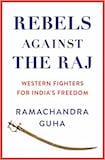
India winning freedom was the first time a major non-white nation had broken the shackles white Europe had imposed on the world for more than 200 years. But while this was the third British colony to gain freedom, unlike America and Ireland, it did not use military means.
Despite being faced with one of the major military powers of the world, Mahatma Gandhi used his famous soul force of non-violence. What also set this British colony apart was that it had no foreign support as America did from France and Spain, with more Frenchmen than Americans dying in Yorktown when George Washington beat the British general Charles Cornwallis.
But while Gandhi’s Congress party neither sought nor had any such foreign backing, there were a small number of foreigners who worked for India’s freedom. This book is their story, if a specialised one. It deals with seven of them: three women and four men, five from Britain, two from the US. All of the were involved with Gandhi and, as author Ramchandra Guha says, identified “completely with India, meeting Indians on absolutely equal terms as friends and lovers and as comrades in the street and prison too”.
The most prominent of the seven was Anne Besant, born and brought up in London but three-quarters Irish, who was greatly affected by the suppression of the Easter Rising. In 1916, rejecting an invitation to attend a reception in honour of the viceroy, she thundered, “I think you hardly understand how we, who are Irish, feel about oppression, and I resent it for Indians more than I do for myself.”
Gandhi as a student in London had heard Besant speak and was inspired by her, and there can be no doubting her contribution to India’s freedom movement. Besant, the first woman president of the Congress, drew on the long campaign for Home Rule in Ireland to support such a movement in India. But she always wanted India to be part of the empire and long before her death in Chennai in 1933 had broken with Gandhi on his call to disobey British laws, which she felt would lead to violence. By then events had left Besant behind as India wanted Purna Swaraj complete independence.
The other six did not have such a political impact, although their stories show how India changed these foreigners.
Philip Spratt was sent to India in 1926 by the British communist party as a messenger to the nascent Indian communist party, preached the Marxist cause and was sentenced to 12 years in prison (later reduced to two) for writing that Lenin’s State and Revolution should be taught to the young. But not long after he would come to admire Gandhi, marry an Indian woman and renounce communism.
Gandhi had an even greater impact on Madeleine Slade, an admiral’s daughter who as a child had lived in India in the style whites did, with the only Indians she knew being servants. But as a grown woman she moved from a love for Beethoven to that of Gandhi, calling him Bapu (father) and Gandhi changing her name to Mira. Living in Gandhi’s ashram, Slade did not mind that Bapu had given her the specific task to record his bowel movements, observing on August 18th, 1929 that he had four movements – at 5am, 6.40am, 2.40pm and 3.40pm – “which has been the best to-day”.
The British, for all the talk of their mighty Raj lasting 1,000 years, were always extremely worried by these whites getting close to Indians and would attempt to evict them from India. With Benjamin Guy Horniman, British officials used tactics similar to those the Home Office have used against jihadis such as Shamina Begum, who went to Syria.
A journalist who had worked for the Daily Express before going to India in 1904, in 1913 Horniman moved from the comforts of British paper the Statesman to edit the Bombay Chronicle, a new paper set up by Indians. But his writings and support for Gandhi so infuriated the British that in 1919 he was given half an hour to pack his belongings and deported back to Britain, on the grounds that he was bringing “into hatred and contempt the Government established by law in India”.
For the next six years the government refused to give Horniman a passport to return to India, despite the fact that by then Labour was in power. He eventually returned in 1926, using a clever dodge by saying he wanted to go France and Italy “for reasons of health” and sneaking into Mumbai via Colombo. He would go on to become one of the great editors of India; independent India would name a square in Mumbai after him. Although I grew up within a five-minute walk of the square, I knew nothing about Horniman when I was young. I doubt if many Indians did either.
Guha has done well to remind us of these forgotten stories, all the more as India, like much of the world, is becoming more xenophobic and intolerant, believing all the virtues lie within national frontier.

